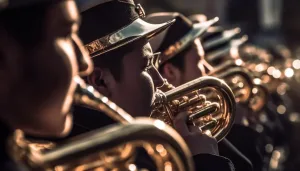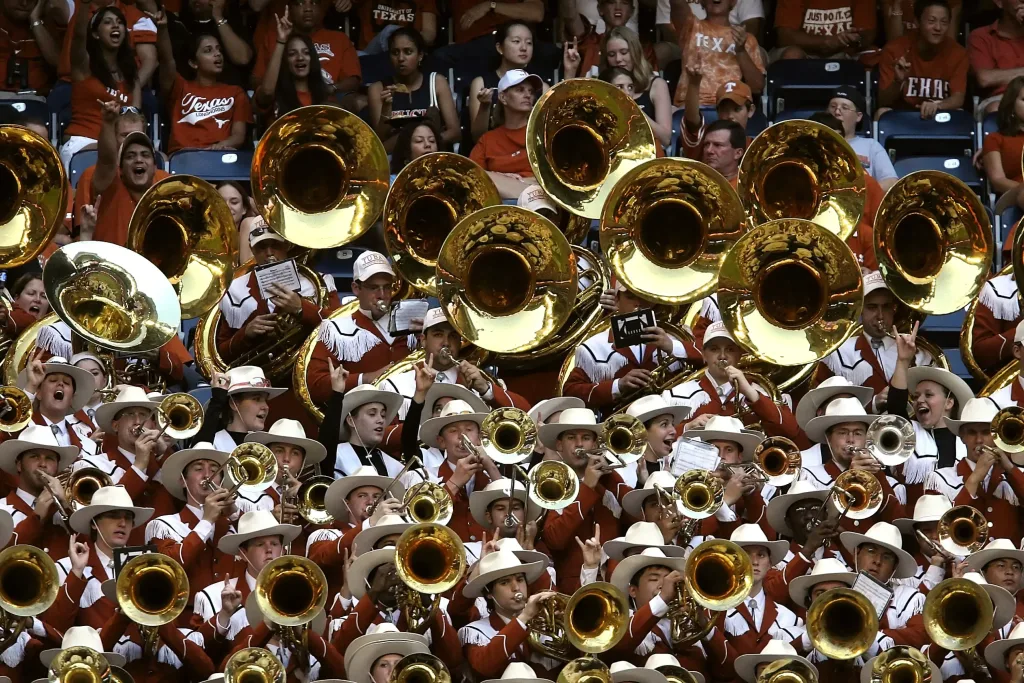In the symphony of sounds that is music, volume plays a pivotal role. Some instruments can pierce through the noise, leaving audiences in awe of their sheer sonic force. This guide will show you the ten instruments that make the loudest sounds. We will talk about how they created their powerful sounds, their importance in history, and how they have influenced music worldwide.

- Electric Guitar
The electric guitar strides onto the stage with unrivaled authority. It’s not just an instrument; it’s a declaration. With its sleek body, it exudes a sense of rebellion and energy. The electric guitar’s defining feature is its ability to harness raw power. Amplified through a stack of speakers, its shredding solos and thunderous power chords have become synonymous with the essence of rock and roll. The electric guitar boasts decibel levels that frequently venture past the 120 marks. The relentless wailing of strings and the sheer force of amplification can make your ears resonate long after the music stops. From the roaring riffs of Jimi Hendrix to the intricate melodies of Eddie Van Halen, the electric guitar is the ultimate vessel of sonic intensity.

- Pipe Organ
Picture a grand cathedral, its towering spires reaching for the heavens. Now, imagine the resounding waves of music that fill its sacred space. This is where the pipe organ reigns supreme. A marvel of engineering, the pipe organ is a symphony in itself. Its colossal sound is brought to life through a complex system of pipes, keys, and pedals. The sound is not just loud; it’s immersive, enveloping listeners in a rich tapestry of harmonies. The pipe organ’s decibel levels can ascend to an astonishing 130, a testament to its ability to command attention and evoke emotions on a grand scale. From solemn hymns to thunderous crescendos, the pipe organ has the power to move souls.

- Trumpet
Brass instruments can cut through the air with brilliance, and the trumpet is a shining example of this phenomenon. The trumpet’s piercing tones demand attention, whether soaring in a symphony or improvising in a jazz ensemble. Its bell-shaped design concentrates the sound waves, allowing them to travel with remarkable clarity. As the player blows air through pursed lips, the vibrations create a sound that can reach a peak of 130 decibels. From the triumphant fanfare of the classical world to the expressive melodies of modern genres, the trumpet’s voice resonates through time and space.

- Drum Kit
A rhythmic powerhouse drives the music forward in every band’s heart: the drum kit. Comprised of various components like the bass drum, snare, toms, and cymbals, the drum kit is a versatile instrument that sets the tempo and mood of a piece. It’s not just about hitting surfaces; it’s about orchestrating a symphony of percussive textures. The drum kit’s decibel levels can easily surge to 130 and beyond, especially in rock concerts where the beats reverberate through the air and vibrate in your chest. The rhythmic explosions created by skilled drummers are a fundamental force that keeps audiences moving.

- French Horn
The French Horn is often associated with elegance and mellow tones in orchestras. However, don’t be fooled by its graceful appearance; the French Horn has a hidden power. Its coiled tubing and flaring bell contribute to its rich timbre and give it the capacity to surprise with volume. The French Horn’s decibel levels can reach up to 115, filling concert halls with warm resonance. As a key player in orchestras, it adds depth and character to compositions, often taking on roles ranging from regal fanfare to lyrical solos.

- Tuba
With its robust appearance and deep, enveloping sound, the tuba is the foundation of many musical ensembles. It’s the anchor of the low end, providing a solid base that underpins melodies and harmonies. Despite its size, the tuba is a master of projection. Its wide bore and large bell enable it to produce thunderous notes surpassing 110 decibels. From marching bands to brass ensembles, the tuba’s presence is felt audibly and physically, making it an indispensable force in the world of low-frequency resonance.

- Bagpipes
Close your eyes and imagine the misty hills of Scotland. The sound of bagpipes carries on the wind, evoking a sense of heritage and nostalgia. The bagpipes symbolize Scottish tradition, and their sound can be likened to a sonic storm. With decibel levels reaching 111, the bagpipes create a distinct auditory experience that transports listeners to a different time and place. Their resonance is captivating, with each note echoing like a call to ancient tales.

- Violin
While the violin may not immediately spring to mind when considering loud instruments, its capacity for intensity lies in its high notes. Often associated with classical music, the violin’s ability to express a wide range of emotions is unparalleled. Its decibel levels can reach 103, particularly when its strings are played fervently. From breathtaking solos to soaring melodies, the violin’s voice can cut through the air delicately and powerfully.

- Trombone
The trombone is a testament to the marriage of mechanics and music. Its sliding mechanism allows for fluid transitions between notes, creating a powerful and resonant sound. The trombone’s decibel levels can ascend to 114, thanks to its unique design that lets players modulate the intensity of their performance. With its ability to alternate between bold fanfare and soulful glissandos, the trombone is a versatile instrument that finds its place in various musical genres.

- Saxophone
The saxophone, often seen as the epitome of cool, straddles the worlds of jazz, rock, and beyond. Its ability to convey emotion and attitude has solidified its status as an essential instrument in modern music. With decibel levels reaching 110, the saxophone’s sultry tones and soaring melodies command attention. Whether belting out bluesy laments or adding flair to a rock solo, the saxophone’s presence is unmistakable and irreplaceable.
The Science Behind the Volume
Now that we’ve introduced the top 10 loudest instruments let’s explore what makes them so thunderous. The sound intensity produced by an instrument is measured in decibels (dB).
Vibrations create sound. Louder instruments typically have larger resonating chambers or mechanisms that amplify these vibrations. The player’s embouchure controls the intensity of brass instruments like the trumpet. In contrast, the electric guitar uses amplifiers to crank up the volume.
Historical Significance
Understanding the historical context of these instruments is crucial to appreciating their impact on music.
Revolutionizing Music
The electric guitar, for instance, revolutionized music in the 20th century. Its amplified sound paved the way for rock and roll, changing the landscape of popular music forever.
The Majesty of the Pipe Organ
Pipe organs have been the musical backbone of grand cathedrals for centuries. They provide solemn accompaniment to religious ceremonies and inspire awe through their power.
Jazz and the Saxophone
The saxophone’s introduction in the 1840s by Adolphe Sax marked a turning point in the music world. It became the soulful voice of jazz and a symbol of expression.
As we conclude, volume can be just as captivating as melody and rhythm in music. The top 10 loudest instruments showcased here have left an indelible mark on the musical landscape, from the earth-shattering power chords of the electric guitar to the soul-stirring tones of the pipe organ. Understanding these instruments’ science, history, and versatility enriches our appreciation of the musical journey they’ve taken us on. Whether you’re a musician or a devoted listener, the thunderous beauty of these instruments is impossible to ignore, making them true sonic powerhouses.


